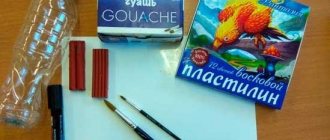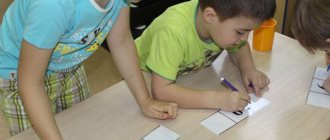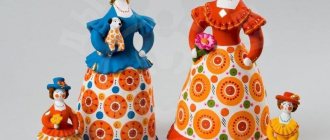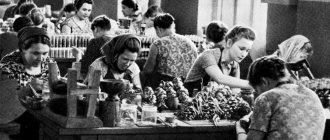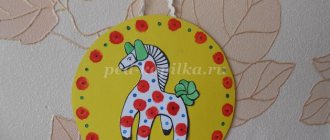Summary of the lesson “Dymkovo toy” for children of the preparatory group
Summary of the lesson “Dymkovo toy” for children 6-7 years old
Author: Naira Igorevna Nersesyan, teacher at MBDOU “General developmental kindergarten No. 144”, Voronezh
Purpose: teachers of senior and preparatory groups, primary school teachers, parents. Goal: Introducing children to folk culture. Objectives: -Introduce the history of the Dymkovo toy. -To cultivate love and respect for the work of folk craftsmen, for the folk art of Russia. -To consolidate children’s knowledge about the process of making Dymkovo toys and the ability to talk about it. -To develop knowledge about the characteristic features of painting toys, the ability to create patterns according to one’s own design. Learn to identify the elements of the geometric pattern of Dymkovo painting (circles, straight and wavy lines, checkered patterns, dots and peas). Learn to paint with Dymkovo patterns. -Develop aesthetic perception, sense of rhythm, color, creativity. Deepen aesthetic knowledge of folk arts and crafts. Preliminary work: drawing up a presentation “Dymkovo toy”, original Dymkovo toys for demonstration, printed stencils on white paper (A4 format) and colored pencils. Lesson plan: - 1. Organizational point 2. Theoretical part.
An introductory conversation about the history and process of creation with a demonstration of Dymkovo toys, paintings, presentations. An explanation of the painting sequence. 3. Final part. Progress of the lesson
Educator: Guys, you all have toys, but what are they made of? Children: Our toys are made of plastic, rubber, metal, wood, fabric. Educator: Let's find out what toys are made in the village of Dymkoye? What is Dymkovo famous for? With his toy. There is no smoky color in it, But there is the love of people. There is something in it from the rainbow, from drops of dew. There is something of joy in her, thundering like bass. (V. Feofanov) Educator: People affectionately and tenderly call this toy “haze.” Where does such an amazing name come from? Let us introduce you to Dymkovo clay toys. I was born in the large settlement of Dymkovo across the river near the city of Vyatka. In ancient times, residents of this settlement, young and old, sculpted clay toys for the spring fair. In winter, the entire settlement is in smoke from the fact that the stoves are heated and toys are burned. On cloudy days, the fog from the river spreads like a light haze. Perhaps this is where the name Dymkoye arose, and the toys began to be called Dymkovo. Dymkovo toys were made for the ancient holiday "Whistling Dance". Later, the fair-festival began to be called "Whistling". What kind of toys are these, let's see? Through the mountain spurs, Through the roofs of villages, A red-horned, yellow-horned clay deer rushes.
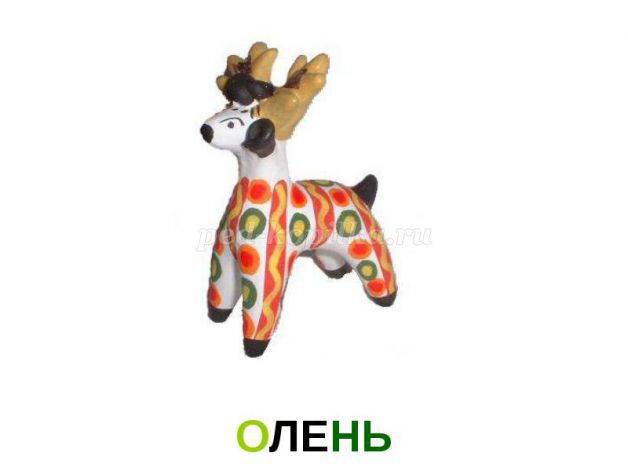
Here is a smart turkey, He is all so fine, The big turkey has all his sides painted. Look, his fluffy tail is not at all simple, It’s like a sunny flower, and then there’s the comb.
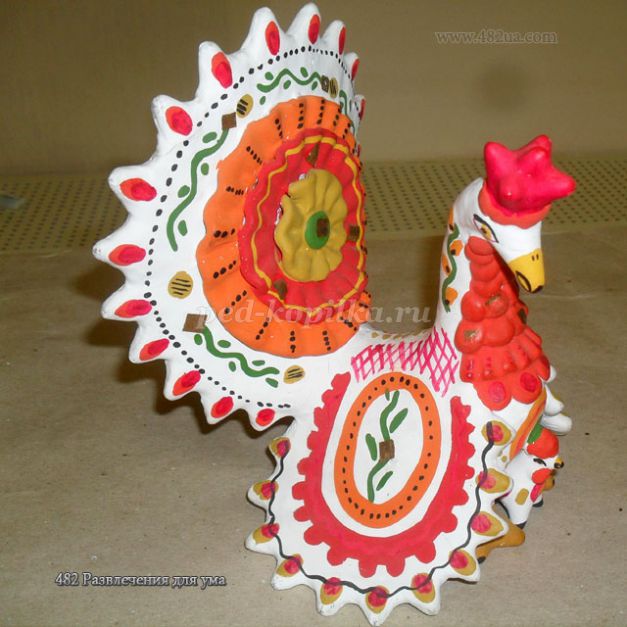
The Dymkovo young lady is all in orange, gold, scarlet and green patterns.
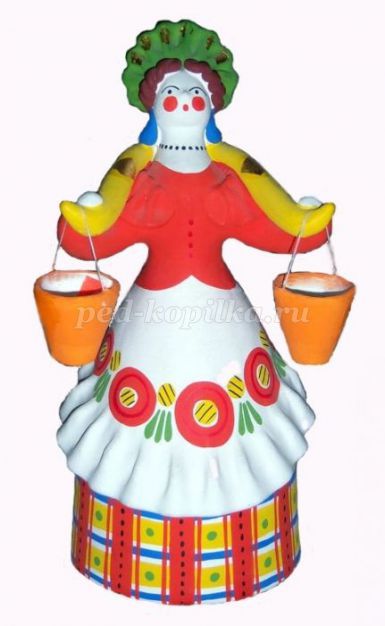
Look how beautiful this girl-soul is, her scarlet cheeks are burning, her outfit is amazing. Even the horses are in festive outfits.

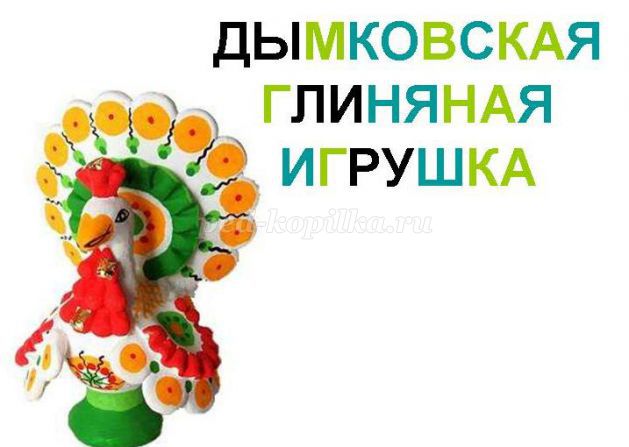
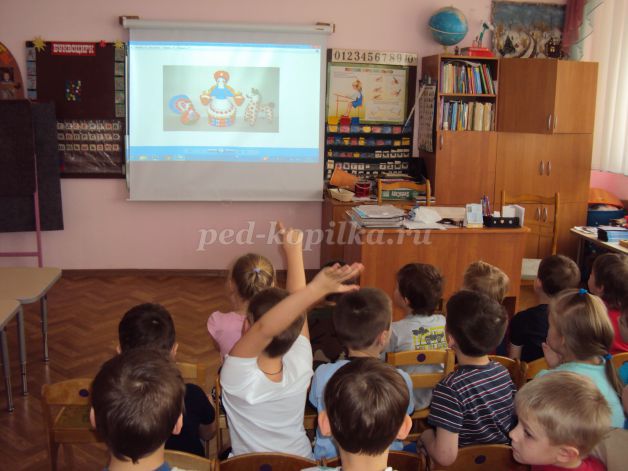
We recommend watching:
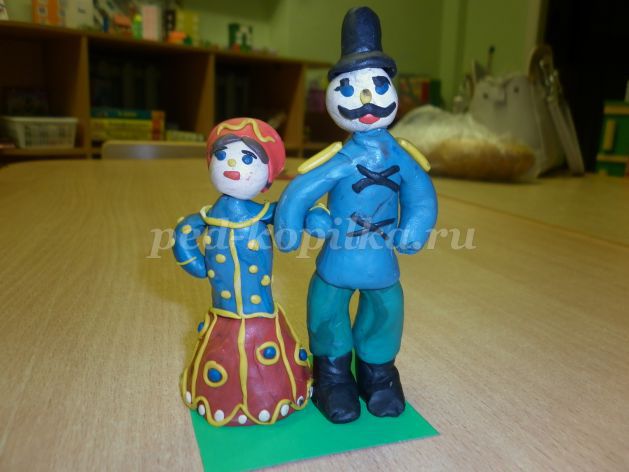
Lesson with older preschoolers. Dymkovo toy Lesson notes on labor training in 2nd grade Notes of GCD in the middle group. Dymkovo toy Abstract of the GCD for sculpting “Dymkovo toy”. Preparatory group
Similar articles:
Modeling figures from plasticine
Master class for preschool teachers. Dymkovo lady
Lesson notes for the middle group. Dymkovo toy
Legend
There is a legend that the origin of the fishery is connected with events of ancient times.
One night, two friendly troops met near the city and, not recognizing each other in the darkness, entered into battle. Many people died in that random battle. Since then, the tradition began to celebrate a funeral feast for the dead every spring. Over time, this story was forgotten. The celebration, having lost its tragic meaning, turned into mass folk festivities - a whistling festival, or pandemonium, where people were supposed to whistle and throw painted clay balls.
Dymkovo fishery in the 21st century
No matter how technology develops, the famous craft still remains manual. Masters create toys, carefully preserving ancient traditions. Therefore, each figurine is unique. Dymkovo toys have been made for centuries and remain popular, being not only souvenirs, but also guardians of folk memory, a symbol of Russian folk culture.
Currently, both enthusiasts and various organizations take care of the preservation of the famous folk craft. In 2010, in the center of Kirov, with support, a monument dedicated to the Dymkovo toy was erected. It represents a family consisting of a mother with a baby in her arms, a man playing the harmonica, a boy with a whistle, as well as a cat and a dog. All figures are made in the classic Dymkovo style.
The Dymkovo toy was among the treasures of Russian art presented at the opening of the Winter Olympics in Sochi in 2014.
Interesting Facts
The history of Dymkovo toys goes back about 400 years. The decline occurred in the middle of the 20th century, but in 1942 the fishery received a new impetus for development. The artist Alexey Denshin brought this to light. Despite the fact that there was a war in the country, he was able to revive interest in toys.
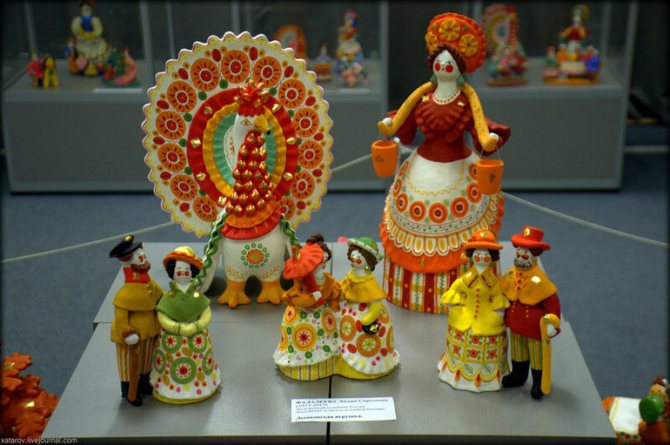
Now the settlement of Dymkovo has become a microdistrict of the city of Kirov . It was here that craftswomen passed on the secrets of making toys from generation to generation. Now they are no longer alive, but in some places wooden houses have been preserved. One man bought land there and when he dug it up, he found fragments of almost 50 figurines. It is possible that one day it will be possible to create a museum that will preserve the history of the Dymkovo toy.
The bridge over the Vyatka River is stylized “hazy” . It looks beautiful and unusual. Similar designs were also used during the draw for the 2022 FIFA World Cup. During the Soviet era, soda machines featured a picture of the Dymkovo lady.
By 2024, it is planned to make the gray industrial city of Kirov bright and original. For this purpose, buildings are decorated with traditional Dymkovo patterns. The craft is gaining popularity again and toys can be bought in many Russian cities.
Preview:
Didactic game:
make a pattern based on Dymkovo painting
Goal: to form an idea of Dymkovo painting, the development of sensory perception, and the development of fine motor skills.
Making the game: cut out silhouettes from thick white cardboard (young lady, horses, deer, water carriers). Elements of Dymkovo painting are cut out from thick colored cardboard (circles, rings, lines, dots, ovals). The child, at his own request, chooses a flat toy and comes up with a composition from Dymkovo elements.
Dymkovo toys are also called Vyatka or Kirov toys. They have a long history, and appeared more than 400 hundred years ago in the settlement of the same name near the Russian city of Vyatka.
History of the fishery

Five centuries ago, beyond the Vyatka River, a small settlement spread its expanses, where Tsar Ivan the Third ordered the inhabitants of the northern regions of Russia to be resettled. Among the new citizens there were a large number of talented craftsmen who were real pottery aces.
In Dymkovo they developed an active activity in the production of clay toys. Whole families took part in the work process. Some were engaged in the extraction of raw materials and prepared a mixture from lump chalk, others sculpted figurines, others specialized in firing, and still others whitened and painted finished products. As you can see, there was something useful for everyone.
The fishery has been actively developing for four hundred years. During this time, a unique technique, specific drawings, and unique images were formed. Dymkovo products and dull shades or blurred patterns are incompatible things. The product was the embodiment of brightness and life.
By the beginning of the nineteenth century, the whistles of the craftsmen of a small village captivated the inhabitants of the whole country. More than one hundred thousand products were produced per year. They were sold in the Orenburg region and Moscow. Fifty-nine families from Dymkovskaya Sloboda worked at the production site. The most skilled craftsmen are the Koshkins and Nikulins.
| The beginning of the twentieth century marked the onset of difficult times for the craft. Dymkovo painting has ceased to be in demand, so the famous families of potters began to look for other options for earning money. |
Cheap plaster products gradually replaced unique whistles from the shelves. Only one craftswoman remained faithful to the traditional creation of clay products - Anna Mezrina. It is she who needs to be thanked for the fact that the fishery has survived to this day and has not been lost in history.
An equally important role in preserving the craft is given to the painter Alexei Denshin. From an early age he was fascinated by Dymkovo toys, carefully copying all the ornaments. Even after the end of the October Revolution, the artist did not lose hope of attracting attention to folk art. He regularly published handwritten albums and collected clay figurines.
Denshin’s efforts were not in vain. In the thirties of the twentieth century, Kirov again began to actively engage in the manufacture of ceramic products.
How to make it?
First, red clay is taken, mixed with brown river sand. This type of clay exists precisely near Vyatka. A figurine is sculpted from it, for example, a rooster, turkey or horse. You have to sculpt the figures in parts. Then they are glued together using liquid clay, and the figure is adjusted by the master. The toy is then dried and fired in a kiln at high temperature. Then they begin to paint it. The patterns are painted with white paint. Previously, paint was made from chalk mixed with milk. Today there are special paints. In addition to white, toys abound in blue, green, and yellow colors, which give them a special cheerfulness. The top of the toys was covered with whipped egg white, which gave them a bright shine and elegance. Each toy is unique because it is made by hand. Among the many figurines collected in museums, you will not find two identical ones. The largest toy museum is located in Kirov.
